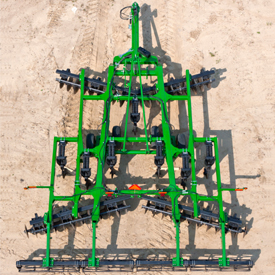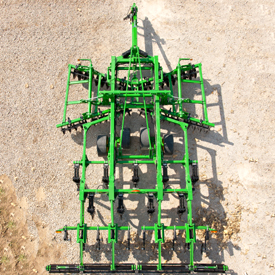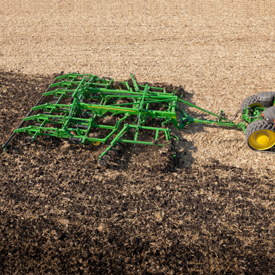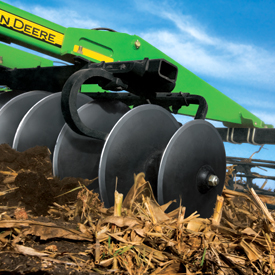| 2720 and 2730: Ripper right choice |
 |
|
|
 |
Both the 2720 and the 2730 Rippers are primary tillage tools capable of meeting customers' requirements of greater productivity during small tillage windows to prepare the preferred soil environment to help plants reach their maximum yield potential. These tillage tools require a similar range of horsepower requirements, but vary in specifications, performance, and price point.
Key factors to consider:
-
Residue levels
-
Crop rotation
-
Field finish
|

|
-
Soil type
-
Soil conditions
-
Moisture levels
|

|
-
Tractor size
-
Size of operation
-
Tillage window
|
|
|
| |
|
| Comparative overview |
| |
2720 Disk Ripper
 |
|
2730 Combination Ripper
 |
|
|
Comparison of working widths
|
Productivity
|
Working width 2720
|
Working width 2730
|
|
Compaction
|
762-mm (30-in.) Ripper shank spacing
|
609-mm (24-in.) Ripper shank spacing
|
|
Ripper Shank
|
5-shank rigid
|
7-shank rigid
|
7-shank narrow
|
9-shank folding
|
11-shank folding
|
7-shank rigid
|
9-shank rigid
|
9-shank folding
|
11-shank folding
|
13-shank folding
|
|
Working widths
|
3.8 m (12.5 ft)
|
5.3 m (17.5 ft)
|
5.3 m (17.5 ft)
|
6.9 m (22.5 ft)
|
8.4 m (27.5 ft)
|
4.3 m (14 ft)
|
5.5 m (18 ft)
|
5.5 m (18 ft)
|
6.7 m (22 ft)
|
7.9 m (26 ft)
|
NOTE: The chart above includes specifications for the working widths. Customers are advised to also consider the transportation dimensions, tractor size, operation size, and tillage window when choosing the ripper model best suited for their needs.
Specifications
|
Considerations
|
Specification
|
2720
|
2730
|
|
Soil conditions
|
Disk configuration
|
Disks Rippers disks
|
Disks ahead of Rippers
|
|
Operation in rocky soil conditions
|
Blade options
|
Gang
|
Individual and gang
|
|
Remaining residue levels
|
Blade size
|
609 mm (24 in.)
|
675x6 mm (26 in.)
|
|
Soil type/moisture: residue sizing
|
Blade spacing
|
279 mm (11 in.)
|
Individual: 457 mm (18 in.) Gang: 279 mm (11 in.)
|
|
Residue incorporation
|
Gang angle
|
Front: 18 degree Rear: 14-16 degree
|
Front: 18 degree Rear: 18 degree
|
|
Crop rotation
|
Maximum blade working depth
|
Up to 152 mm (6 in.)
|
Up to 203 mm (8 in.)
|
|
Field finish
|
Finishing attachments
|
Round bar basket, knife edge basket, less
|
Round bar basket, knife edge basket, coil tine harrow, less rear
|
|
Ease of operation
|
Operational areas
|
Ripper shanks; baskets
|
Ripper shanks; baskets; front disks; closing disks
|
|
Horsepower requirements
|
Engine horsepower
|
26-37 kW (35-50 hp) per shank
|
26-41 kW (35-55 hp) per shank
|
Additional ripper model specifications can be accessed using the following links: 2720 specs and 2730 specs. |
|
| |
|
Key value propositions for 2720
2720 Ripper video
The 2720 has the ability to position the disks independently from the ripper shanks set at 762 mm (30 in.) to minimize plugging and reduce horsepower and fuel requirements. The disk-ripper-disk configuration allows the front gangs to bury residue. The ripper shanks shatter compaction up to 406-mm (16-in.) deep. The rear disk blades level soil, providing additional soil and residue incorporation. The hydraulically adjustable rolling baskets help break up clods to leave the preferred field finish.
Key value propositions for 2730
2730 Ripper video
The 2730 integrates four operational areas into one system, reducing overall tillage system costs and increasing asset utilization. The 2730 features independent hydraulic adjustability of disks, ripper shanks, closing disks, and leveling attachments. Superior residue flow is achieved with 1270 mm (50 in.) of ripper shank fore-aft spacing. To fully fracture compaction layers, the shanks are set at 610-mm (24-in.) side-to-side spacing. With under frame clearance of 953 mm (37.5 in.) and an overall machine length of 13 m (42.5 ft), the 2730 delivers nearly plug-free operation.
Common applications
 |
- For a customizable field finish, both the 2720 and 2730 are available with either knife-edge or round-bar baskets that can be operated with constant active hydraulic down pressure in float or raised completely off the ground. These settings are hydraulically adjusted from in the cab, and changes can be made on-the-go. Additionally, both machines can be ordered less leveling attachments, and a coil tine harrow is available with the 2730.
- Single point depth control accurately sets ripper point depths up to 406 mm (16 in.) deep.
- Both machines deliver on customer needs of higher performance with larger operating widths, increased uptime, maintenance-free components, fewer grease points, larger, durable tires, and a lower cost of operation through machines that prepare the soil for one secondary seedbed preparation pass.
|
|
|
| |
|
| Productivity |
| |
2720 Disk Ripper
 |
|
2730 Combination Ripper
 |
|
|
Key value propositions for 2720
While both machines have similar horsepower requirements, the 2720 will demand less horsepower. The horsepower rating for the 2720 is between 26 to 37 kW (35 to 50 hp) per shank, and the operating speed range is between 8 to 11 km/h (5 to 7 mph). This means a 5- or 7-shank 2720 can be pulled with something similar to a John Deere 8R Series tractor. In most situations, the 2730 models will generally require a tractor comparable to a John Deere 9R Tractor Series.
Key value propositions for 2730
To accomplish all of the functionality the 2730 delivers in one pass, it comes with a need for horsepower. The robust frame, larger disk blades that can work up to 203 mm (8 in.) deep, and extra built-in disk width is going to take 26 to 41 kW (35 to 55 hp) engine hp per shank. Additionally, up to five selective control valves (SCVs) and 17,237 kpa (2500 PSI) is required for the folding models when the rolling basket is equipped. The 2730 is designed for 8 to 11 km/h (5 to 7 mph) operating speeds. |
|
| |
|
| Residue management |
| |
2720 gang blades
 |
|
2730 individual blades
 |
|
|
Customer value
Both the 2720 and 2730 are primary tillage tools designed to manage high residue levels and flow soil for one secondary pass seedbed preparation.
Key value propositions for 2720
The 2720 Disk Ripper is designed with the front gangs set ahead of the shanks at an 18-degree angle. The rear gang positioned behind the shanks can be set at 16 degrees for more aggressive disking or may be adjusted to 14 degrees for very light soils and minimal residue conditions. The 2720 is designed to leave as much as 30 to 45 percent residue coverage on the surface.
Key value propositions for 2730
The large 674-mm (26-in.) 2730 disk blades are set ahead of the ripper shanks and can be hydraulically adjusted in cab to be raised completely out of the ground. The ability to independently adjust the front disks based on varying conditions allows the operator to optimize desired residue sizing and mixing.
The disks are available in either individual disk blades or in a gang-type configuration. The front and rear blades are set at an 18-degree angle on either 460-mm (18-in.) spacing for individual blades or 280-mm (11-in.) spacing for gang blades to provide an aggressive disking action up to 203-mm (8-in.) depths. The 2730 is designed to reduce residue by up to 60 to 80 percent. |
|
| |
|
|
|
|
 |
 |
Product features are based on published information at the time of publication and are subject to change without notice. All
trademarked terms, including John Deere, the leaping deer symbol and the colors green and yellow used herein are the property
of Deere & Company, unless otherwise noted. Availability of products, product features, and other content on this site may
vary by model and geographic region.
Engine horsepower and torque information for non-Deere engines are provided by the engine manufacturer for comparison purposes only.
Actual operating horsepower and torque will be less. Refer to the engine manufacturer's Web site for additional information. |
|
| |
|
| Copyright © 1994-2015 Deere & Company. All Rights Reserved. |
|
|